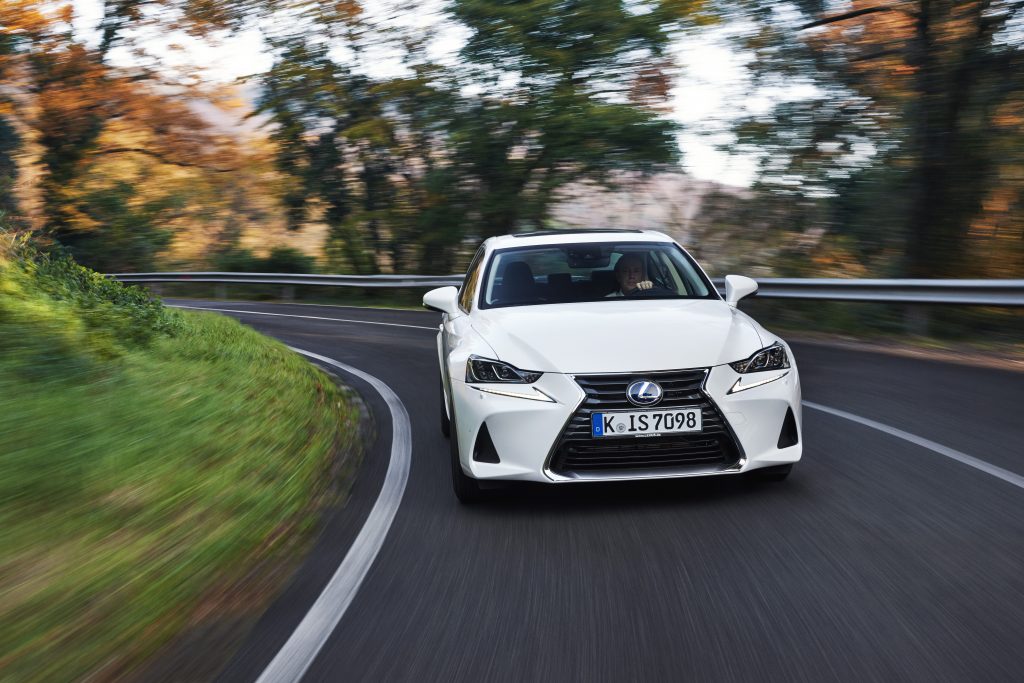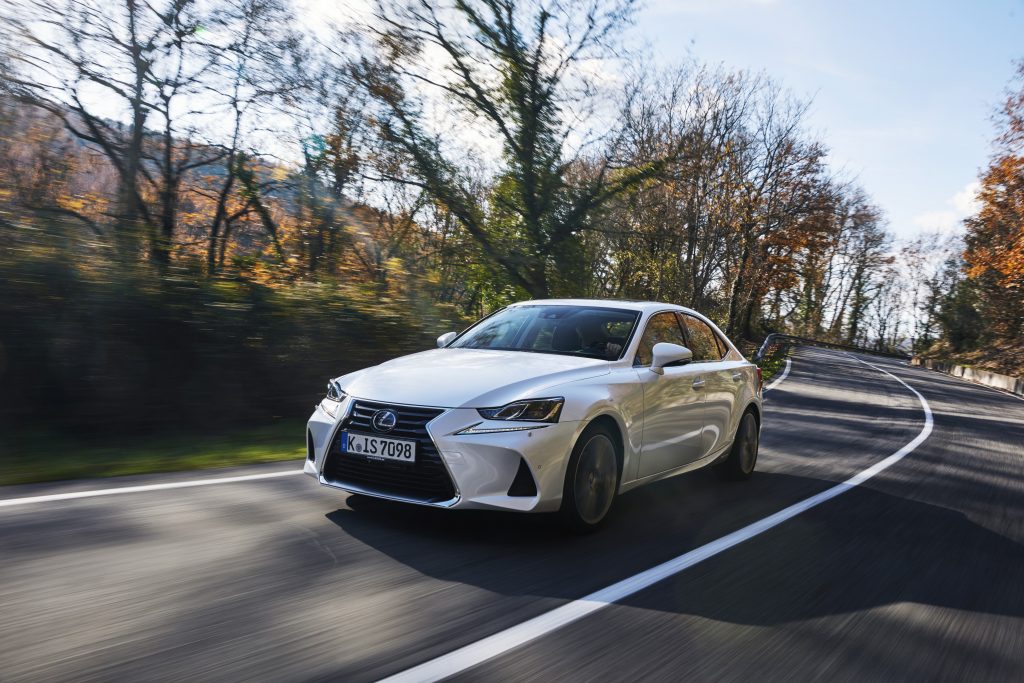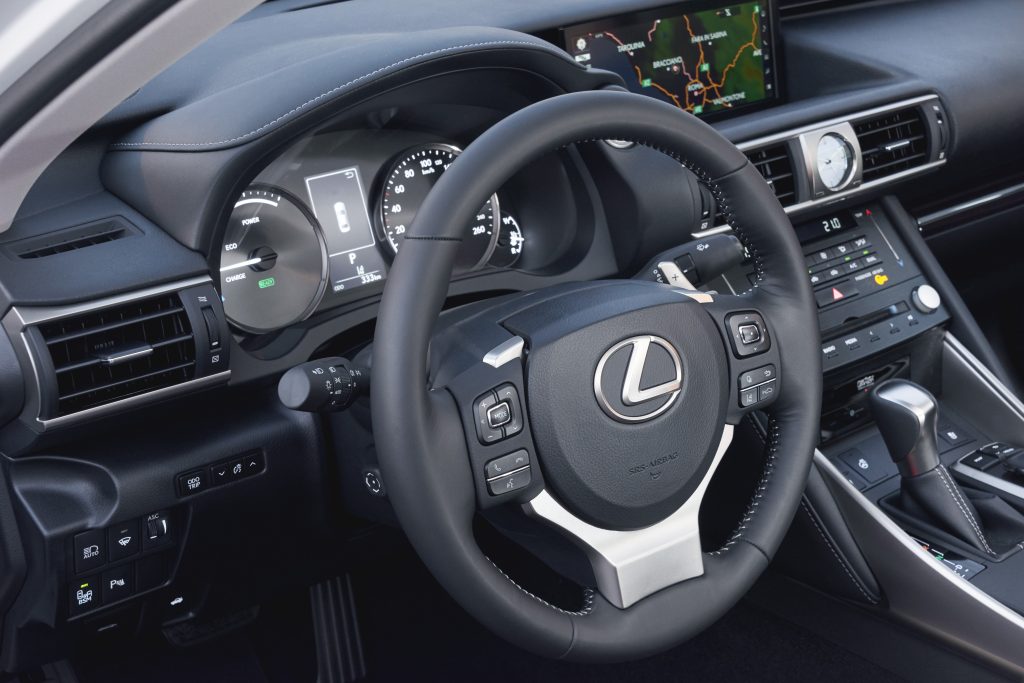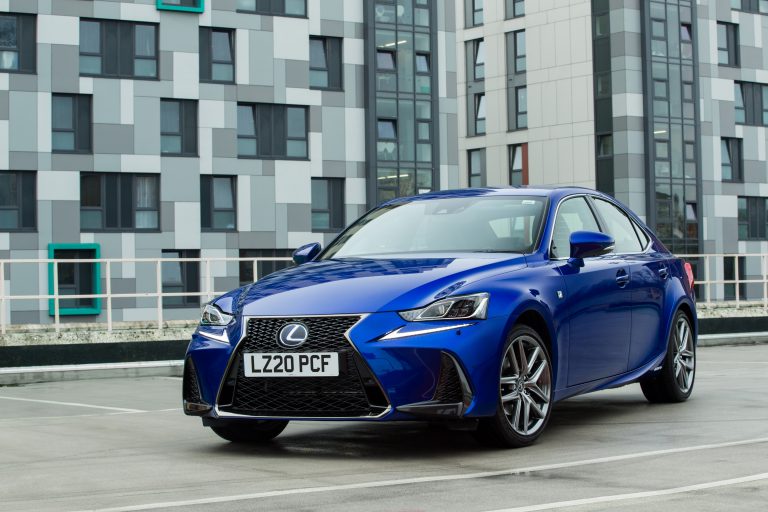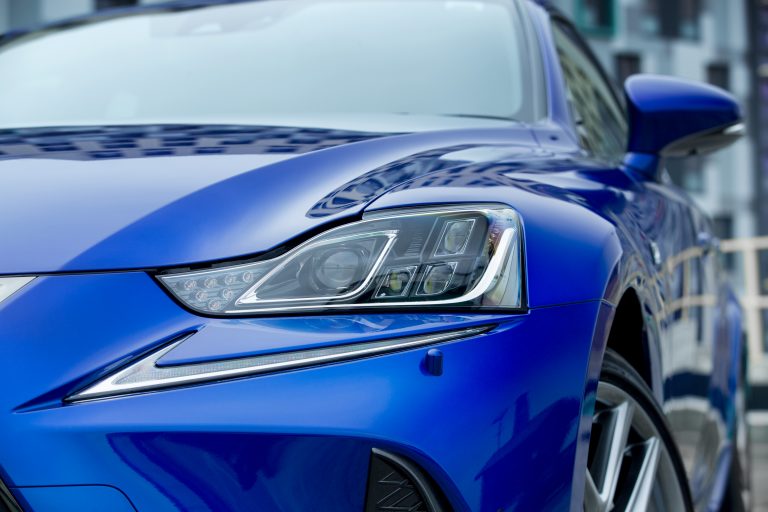The New 2017 Lexus IS (European Media Launch)
This press kit was issued for the European media launch of the revised, 2017 Lexus IS. The contents are UK-specific and cover all the upgrades and improvements made to the car. For the full IS press kit, visit the IS home page on the Lexus UK media website here.
Full gallery of photographs from the launch can be downloaded from here.
THE NEW 2017 LEXUS IS
With the benefit of more than one million global sales, the important status of the IS saloon within the Lexus range remains beyond question. It is thus fitting that the mid-lifecycle changes introduced for the third generation model are not simply cosmetic; they demonstrate a commitment to achieving the best possible dynamic performance, matched by refined styling and a cabin that exemplifies craftsmanship quality, superb comfort and functionality rooted in finely judged HMI design.
Lexus’s priorities for the new IS are made clear by Chief Engineer Naoki Kobayashi. He said: “Before starting work on the new IS, my designers travelled the world, interviewing customers and searching for inspiration. This research phase was vital, as we were challenged with taking the already successful IS to the next level.
“After months of design sketches and computer time, our craftsmen were ready to model the bodywork. While keeping its athletic stance and long coupe roofline, we’ve given the IS a more confident look. New design elements include a stronger spindle grille, enhanced side kick-up line and jewel-like LED lighting that all combine to create the most distinctive IS we have ever built.”
Kobayashi’s team invested an unprecedented level of attention for a mid-lifecycle programme, including putting the car through extensive road and test-track driving, demonstrating the even higher standards Lexus is applying to its vehicle development. New lightweight suspension components and adjustments to the coil springs, shock absorbers and stabiliser bar all contribute to a more rewarding drive, without diminishing ride comfort.
The new model also introduces customers to the benefits of Lexus Safety System+, equipping the car with a raft of advanced technology features that can help prevent accidents happening and reduce the consequences should the worst happen. Features such a Blind Spot Monitor and Rear Cross Traffic Alert provide the driver with improved warnings of potentially unseen hazards and the LED headlights provide a deeper and wider field of illumination in night-time driving.
The attention to detail can be witnessed in the cabin, with small but telling adjustment to the shape, location and appearance of controls, reflecting both higher sensory quality and a focus on superior HMI performance. Key changes include a larger, 10.3-inch high-resolution monitor for the Lexus Premium Navigation multimedia system and the availability of new precision laser-etched dark wood trim inserts, as first seen in the new RX luxury SUV.
New alloy wheel designs, new colour choice for the exterior and the cabin and a more powerful 10-speaker Pioneer Premium Sound audio package further add to the increased customer appeal of the new IS. The range retains its proven powertrains: the full hybrid IS 300h and the 2.0-litre turbocharged petrol IS 200t with eight-speed Sport Direct Shift automatic transmission.
EXTERIOR AND INTERIOR DESIGN
- Evolution of IS design with a stronger frontal treatment
- New interpretation of Lexus’s signature spindle grille
- New alloy wheel designs
- Improved cabin quality with Takumi craftsmanship detailing
- Larger Lexus Premium Navigation display
- New 10-speaker Pioneer Premium Sound audio
EXTERIOR DESIGN
Because the styling of the current generation IS has proved so popular, Lexus has kept the essence of the car’s exterior appearance intact. However, the front of the new model has undergone a transformation, with new headlamps, large air intakes in the bumper and a further evolution of the signature Lexus spindle grille design.
The reshaped headlamps – now full LED units – have a more pronounced look than before and extend inwards, creating an eye-catching shape that accentuates the “L” configuration of the daytime running lights. The bumper, with its smoothly integrated air intakes, flows from the front wings to generate a more powerful road presence.
The new spindle grille angles back at a higher point than before, changing the proportions of its upper and lower sections, producing a sportier appearance and giving the impression of a lower centre of gravity in the car, while blending smoothly into a reshaped bonnet.
The IS’s profile has been rendered sleeker by a stronger character line that runs along the length of the car, and by a choice of 16, 17 and 18-inch wheel designs. The range of alloy wheels includes a new 17-inch design with a contrasting silver and machined finish for Executive Edition, Advance and Luxury grade, and new multi-spoke 18-inch rims for the IS Premier models.
The changes to the rear are highlighted by new triple-layered LED light guides and new trapezoidal, chrome-finished exhaust tips (IS 200t), further accentuating the IS’s sporting nature.
Two new colours, Deep Blue Mica and Graphite Black have been added to the choice of exterior paint finishes.
ENHANCED INTERIOR DESIGN AND HMI
Many carefully considered improvements have been made to the new IS’s cabin that raise the levels of visual and tactile quality and improve the HMI (human-machine interface) qualities of displays and controls.
Multimedia systems, Remote Touch Interface and connectivity
The centrally mounted screen for the Lexus Premium Navigation multimedia system has been significantly increased in size, from seven to 10.3 inches. This new, high-resolution monitor presents larger and clearer images and a split-screen design so that different information displays can be presented simultaneously, making it easier for the driver to read at a glance and select functions, with least distraction from the job of driving.
All new IS models are fitted with a multimedia system with USB, Aux-in and Bluetooth connectivity. The Lexus Premium Navigation package also includes the latest iteration of the Remote Touch Interface control and in-car WiFi as an option. It can also be operated using voice commands. The Remote Touch Interface control on the centre console also benefits from improved HMI design with the addition of an “Enter” button on its side to make operation easier.
The standard Lexus Media Display has a seven-inch screen and content is controlled by means of a rotary dial in the centre console.
Revised cabin features with Takumi craftsmanship
In the centre of the dashboard, the audio and ventilation control panel has been adjusted so that it sits neatly between the knee bolsters; its surface has a fine new hairline finish.
Representative of the Takumi craftsmanship that distinguishes every Lexus model, new stitching is featured around the instrument binnacle hood, adding to the sporting feel of the cockpit, as do refinements made to the speedometer and tachometer.
Thanks to a reduction in the width of the audio and ventilation control panels, the driver and front passenger knee pads now run the full length of the centre console. They have also been made thicker to provide extra cushioning, with new stitching additionally featured on F Sport and Premier models. There are also new cupholders (divided by a useful slot to stow a mobile phone), a satin finish for the gear lever, a larger, leather-wrapped and stitched palm rest for the Remote Touch Interface control, and new dial markings on the analogue clock.
New laser-etched dark wood trim inserts
The IS is available for the first time with laser-etched dark wood trim inserts, fitted as standard to Premier grade models. Produced for Lexus by the skilled craftspeople at Yamaha Fine Technologies, they are made using a technique applied in the manufacture of some of the world’s finest musical instruments.
The process uses precise laser-etching to cut through the wood veneer to expose a layer of aluminium beneath, creating a striking design that draws on the contrast between the rich qualities of the wood and the cool appearance of the metal. The effect is heightened by a clear, protective top coat, polished to a high shine.
Improved Pioneer Premium Sound System
The Pioneer Premium Sound System featured with the Lexus Premium Navigation package has been improved with the introduction of two additional 9cm speakers with a Coherent Source Transducer, positioned on each side of the instrument panel, integrating a tweeter and mid-range speaker. This takes the system’s full array to 10 speakers, ensuring an even higher sound reproduction quality.
The system includes a fully digital, Class-D, eight-channel amplifier capable of creating virtually distortion-free sound with minimal voltage losses. The natural sound dynamics and rich harmonies generated by the high definition amplification are faithfully reproduced by a 10-speaker layout, which includes a 55mm wide-range tweeter.
The system’s functions include AM/FM/DAB radio tuner, DVD/CD player and Bluetooth.
15-speaker Mark Levinson® Premium Surround System
For a true live concert-quality in-car audio experience, the IS offers the option of a 15-speaker Mark Levinson® Premium Surround System. Designed specifically for the IS’s interior, the package produces 5.1-channel digital surround sound, delivered through a speaker array that uses GreenEdge™ technology to produce twice the sound for the same level of energy consumption as a conventional system. An Auto Volume System automatically adjusts performance between different artists and recordings to ensure the best sound delivery.
New interior colour options
There are also new interior upholstery and colour choices, with combination fabric and Tahara seat coverings in black with Garnet Red detailing and black trim inlays for the IS 300h Sport. For the IS 300h Advance and Luxury there is a new Sandstone leather finish, with the Luxury versions also offering a warm metal inlay finish. Luxury and Premier models can be specified with new Noble Brown leather with Ivory accents.
IS F SPORT
The new IS range includes F Sport versions of both the IS 300h and IS 200t, offering a sportier dimension in both styling and performance.
In design terms, the F Sport models make an even stronger visual statement, with the new spindle grille having a dark chrome finish and an exclusive three-dimensional “F” mesh pattern. The lower grille section also incorporates functioning cooling ducts for the brakes; these share a continuity of style with the car’s side garnishes and are designed to contribute to the car’s improved aerodynamics. Larger, 18-inch multi-spoke alloy wheels are provided as standard.
In the cabin the details include a three-spoke F Sport steering wheel, supportive sports front seats, LFA-style instrumentation, aluminium-effect trim inlays and an aluminium pedal set. Adaptive Variable Suspension (an option within the Premier Pack) and specially tuned steering ensure the car’s handling lives up to the promise of its emphatic looks.
F Sport with Premier Pack
Customers can raise the specification of the IS 300h F Sport to match the Premier grade model by specifying the optional Premier Pack; on the IS 200t F Sport, the pack is provided as standard. Features include F Sport leather seats with eight-way front seat power adjustment, Mark Levinson audio system, Blind Spot Monitor with Rear Cross Traffic Alert, Adaptive Variable Suspension and Naguri-style aluminium trim inserts.
UK Range and pricing
The 2017 Lexus IS retains its existing grade line-up with the IS 300h hybrid available in SE, Executive Edition, Sport, Advance, Luxury, F Sport and Premier trims. The turbo petrol-powered IS 200t is available in Premier and F Sport specification, in the latter case with the IS Premier Pack included, adding equipment features to match the range-topping grade.
| MODEL | OTR PRICE |
| IS 300h SE | £29,995 |
| IS 300h Executive Edition | £30,995 |
| IS 300h Sport | £31,495 |
| IS 300h Advance | £32,995 |
| IS 300h Luxury | £34.495 |
| IS 300h F Sport | £34,745 |
| IS 200t Premier | £37,995 |
| IS 300h Premier | £38,995 |
| IS 200t F Sport + Premier Pack | £38,995 |
| IS 300h F Sport + Premier Pack | £40,995 |
PERFORMANCE
- New IS aerodynamics fine-tuned in hundreds of hours of wind tunnel testing
- New lightweight and high-rigidity alloy suspension components
- Revised coil springs and shock absorbers and new rear stabiliser bar
- Performance honed on Japan’s most demanding routes
FOCUS ON AERODYNAMIC EXCELLENCE
Lexus has spared no effort in ensuring the new IS achieves the best possible performance, For example, the car’s aerodynamics have been scrutinised in hundreds of hours of testing a 260-metre long wind tunnel, capable of generating hurricane-force winds. This enabled many detailed adjustments to be made, even down to adding an area of aluminium tape behind the rear bumper to achieve a smooth airflow.
Chief Engineer Naoki Kobayashi explained: “At 100km/h a car’s performance is affected largely by wind resistance. Even driving around the city, aerodynamics affects both fuel efficiency and handling. It might not be the easy way, but this approach has resulted in one of the most refined saloons ever built.”
Revised suspension and steering for improved dynamic performance
The IS’s dynamic performance has been improved through precisely calculated revisions to the front and rear suspension and steering.
The front double wishbone suspension has a new forged aluminium lower arm assembly which delivers a 49 per cent increase in rigidity compared to the steel member it replaces. It also benefits from a new No1 bush that is 29 per cent more rigid than before and a stiffer anti-roll bar. By using alloy material in this way, Lexus has been able to increase rigidity without incurring any weight penalty.
Together these elements offer a marked improvement in steering response at cruising speeds. The front system also has a new upper support bush, a revised coil spring rate for better roll control, new shock absorber components and revised damper settings, helping achieve improved yaw response.
The rear multi-link suspension has also gained a new No1 bush for the upper arm, a stiffer stabiliser bar, new shock absorber components and revised damper settings.
Changes to the shock absorbers ensure that damping force can be generated from very low vehicle speeds, helping maintain stability and ride comfort.
The electric power steering’s ECU settings have been reassessed and revised in order to achieve better steering control.
As a result of these comprehensive measures, both the standard and F Sport IS models demonstrate better ride quality, body control, rear wheel traction and straight-line stability, as well as better steering response and feedback.
Before the dynamic changes to the new IS were sanctioned for production, they underwent stringent assessment with extensive testing on-road and on test tracks to pinpoint where final tuning could be made to gain the ideal results from the package of dynamic improvements.
Vehicle Dynamics Integrated Management
Lexus’s unique Vehicle Integrated Dynamics Management (VDIM) is featured on all IS models, improving the car’s performance, traction control and stability. It uses comprehensive status data from sensors throughout the vehicle to co-ordinate operation of the ABS, Electronic Brakeforce Distribution (EBD), Traction Control (TRC) and Vehicle Stability Control (VSC) with the electric power steering (EPS).
Through this integration of the all the elements related to vehicle movement, including motor torque, braking and steering, VDIM not only optimises the activation of the braking, stability and traction control systems, it can also further improve the vehicle’s kinetic performance.
Control systems are usually activated immediately after a vehicle reaches the limits of its dynamic envelope; VDIM operates before that limit is reached. This means the IS’s dynamic limits are expanded, while vehicle behaviour becomes smoother at the limit, thanks to less obtrusive intervention by the active safety systems, securing a more enjoyable driving experience.
When braking in a corner, for example, a loss of rear tyre grip can provoke understeer. Through the car’s EBD function, the use of linear brake actuators makes it possible to initiate control before the car’s limit has been reached. VDIM apportions the appropriate braking force to each wheel, ensuring the vehicle remains stable by pre-emptively restraining the spinning tendency and, at the same time, delivering superior braking performance.
Even stronger braking in a corner can result in front-wheel lock-up and a loss of grip that causes the car to understeer, Once again, by independently controlling the braking force to all four wheels via the EBD, VDIM helps to prevent front-wheel lock-up and regain vehicle balance, offering seamless control until the ABS and VSC functions take over.
Furthermore, VDIM can augment operation of the VSC, via the electric power steering actuator, providing steering assistance to reduce torque steer when braking on surfaces with varying levels of grip. It can also introduce steering torque assistance in understeer and oversteer conditions, helping the driver optimise the front wheel steering angle and keep the car stable with the least input.
POWERTRAINS
- New IS retains its proven full hybrid and turbo petrol powertrains
- IS 300h with smooth and efficient full hybrid system, featuring 2.5-litre Atkinson cycle petrol engine, compact and powerful electric motor and electronic continuously variable transmission
- IS 200t powered by 2.0-litre turbocharged petrol engine, matched to an eight-speed Sport Direct Shift automatic transmission originally developed for the RC F performance coupe
- Drive Mode Select with new “customise” function
The new IS range retains the model’s established choice of powertrains, the IS 300h full hybrid petrol and the IS 200t 2.0-litre turbo petrol.
FULL HYBRID IS 300h
The IS 300h, which accounts for the great majority of European IS sales, delivers exceptional smoothness and efficiency while preserving the driver rewards that are fundamental to the IS’s traditional appeal. The full hybrid powertrain combines a 2.5-litre, four-cylinder Atkinson cycle petrol engine with a compact, powerful electric motor to provide smooth, responsive performance, supported by Dual VVT-i intelligent variable valve timing, Lexus’s D-4S fuel injection technology and a high-efficiency exhaust gas recirculation system.
The powertrain features an electronic continuously variable transmission (E-CVT) with a sequential shift mode, operated using fingertip paddle controls on the steering wheel.
The Lexus Hybrid Drive’s advanced engineering delivers low exhaust emissions and fuel economy, with official combined cycle test figures from just 97g/km and 67.3mpg respectively, strengthening the car’s appeal in markets where environmental performance and ownership costs are key customer considerations.
IS 200t TURBO PETROL
The IS 200t is powered by a 2.0-litre, four-cylinder, twin-scroll turbocharged petrol engine, matched to the smooth-shifting eight-speed Sport Direct Shift automatic transmission that Lexus originally developed for the IS F and which is also featured in the RC F performance coupe.
The engine benefits from a number of innovative technologies, including D-4ST direct fuel injection and Variable Valve Timing-intelligent Wide (VVT-iW) which allows the engine to switch between Otto and Atkinson cycle operation by varying the opening angle of the intake valves. The unit uses direct, high-pressure fuel injection into the cylinders and a low-pressure system for injection into the ports. Power is rated at 241bhp/180 kW at 5,800rpm, with maximum torque of 350Nm delivered between 1,650 and 4,400rpm.
DRIVE MODE SELECT WITH NEW “CUSTOMISE” FUNCTION
The IS’s Drive Mode Select system features up to five switchable driving modes, engaged using a rotary control on the centre console: Eco, Normal, Sport and, on models equipped with Adaptive Variable Suspension, Sport S and Sport S+. The new IS extends the system’s functionality with a new “customised” option that lets the driver adjust the control of chassis settings, throttle response and air conditioning operation to suit their personal preference.
Switches immediately below the rotary control are used for engaging all-electric EV (IS 300h hybrid models) and Snow modes.
CLASS-LEADING SAFETY TECHNOLOGY
- New IS benefits from the advanced protection provided by Lexus Safety System+
- Package of features includes Pre-Crash System, Adaptive Cruise Control, Lane Departure Alert and Automatic High Beam
- IS accorded top five-star safety rating in Euro NCAP testing
- Comprehensive passive safety provisions and pedestrian protection, including a pop-up hood
- Full LED headlights deliver improved field of illumination
LEXUS SAFETY SYSTEM+
In line with Lexus’s commitment to offering state-of-the-art technology to a wider audience, at an attractive price, all versions of the new IS (bar the entry-level SE model) adopt Lexus Safety System+, a set of active safety features designed to help prevent or mitigate collisions in a wide range of traffic situations.
Pre-Crash System
The new IS is equipped with a Pre-Crash System (PCS) that can help the driver avoid a collision, or lessen the consequences of an impact, even at high speed.
PCS features a front-mounted millimetre-wave radar and camera which scan the road ahead to detect obstacles, effective not just when driving straight ahead, but also when cornering. The PCS computes data from sensors on factors such as vehicle speed, steering angle and yaw rate inputs to help determine the risk of a rear-end collision with a vehicle ahead. If it recognises a high risk, it will trigger a warning buzzer and illuminate a “BRAKE” command in the multi-information display to alert the driver to take action.
The moment the brake pedal is pressed the system initiates Pre-Crash Brake Assist to provide optimum braking force. This can achieve deceleration of up to 60 km/h (37mph), slowing the vehicle to reduce the severity of any impact, or potentially bringing the vehicle to a stop before an impact occurs.
If the driver does not respond to the alerts and does not apply the brakes, the Pre-Crash Brake will automatically operate to reduce the vehicle’s speed.
The Pre-Crash Safety system also features pedestrian protection. If a pedestrian is detected in front of the IS, automatic braking will be activated when the car is travelling between about 30 and 80 km/h (19 and 50mph).
Adaptive Cruise Control
The PCS radar and camera are also used to provide Adaptive Cruise Control, which helps the driver maintain a safe distance from the vehicle in front. Once the way ahead is clear, the IS will automatically accelerate smoothly back to its pre-set cruising speed; if the car has been brought to a halt, the driver only has to press the accelerator briefly to reactivate the system.
The system can be operated in two modes – constant speed control (like a conventional cruise control system), or vehicle-to-vehicle distance control. The driver can set long, medium or short vehicle-to-vehicle distances according to preference; the control settings are shown on the multi-function display.
Lane Departure Alert and Sway Warning
The Lexus Safety System+ package also includes Lane Departure Alert (LDA), which uses a camera mounted behind the rear-view mirror to track the vehicle’s course between lane markings painted on the road surface. If it detects that the vehicle is moving out of its lane without the turn indicators being used, it will light up a warning on the multi-information display and sound a buzzer alert, prompting the driver to steer the IS back to its correct path.
The system also includes a Sway Warning function. This monitors the car’s position in its lane and the driver’s steering inputs. If it detects degrees of vehicle swaying, caused by driver distraction or drowsiness, it will sound an alert and display a warning on the multi-information display, recommending the driver takes a break.
Automatic High Beam
The IS’s Automatic High Beam (AHB) headlight system maximises night-time visibility by automatically switching to low beam when it detects the lights of oncoming traffic or vehicles ahead. This has the benefit of maximum, safe operation of high beam lighting, improving the driver’s field of vision without the risk of dazzling other road users.
Traffic Sign Recognition
The Traffic Sign Recognition (TSR) system on the new IS recognises traffic signs using the windscreen mounted camera, and provides information to the driver in the multi-information display. TSR can detect signs that are compliant with the Vienna Convention (including electroluminescent and flashing signs).
ADDITIONAL ADVANCED SAFETY FEATURES
The new Lexus IS goes beyond the level of protection afford by Lexus Safety System+ to make use of further advanced systems and controls to improve safety and vehicle control. The driver can make use of a Blind Spot Monitor and Rear Cross Traffic Alert (Premier Grade and Premier Pack option) for safe manoeuvres and all versions of IS are fitted with an Auto Location Tyre Pressure Warning System. Vehicle Dynamics Integrated Management continues to provide ideal co-ordination of the car’s braking, traction control and stability control functions with the electric power steering.
Blind Spot Monitor and Rear Cross Traffic Alert
The new IS is available with a Blind Spot Monitor, which uses a rear-mounted radar to detect vehicles travelling in adjacent traffic lanes, outside the driver’s line of sight in the door mirrors. An indicator light is illuminated in the appropriate mirror to alert the driver when another vehicle is detected in the blind spot. If the turn indicator is operated while a vehicle is in the blind spot, the warning light in the mirror will flash on and off.
The same radar is used to provide the Rear Cross Traffic Alert function. This warns the driver of an approaching vehicle from either side when reversing out of a parking space, triggering a warning light in the corresponding door mirror and sounding a warning buzzer.
Auto Location Tyre Pressure Warning System
The Auto Location Tyre Pressure Warning System (AL-TPWS) works using data from individual sensors integrated into each tyre’s air valve assembly. This allows the air pressure values for each tyre to be shown on a display in the driver’s instrument binnacle. When low pressure is detected, the value of the affected tyre is shown in amber to alert the driver. This provides more precise information for the driver, compared to conventional systems which do not indicate which tyre requires attention.
The system is activated the moment the ignition is turned on, so the driver can check tyre pressures instantly, before driving off. Ensuring all tyres are at their recommended pressures contributes both to safer driving and optimum fuel economy.
PASSIVE SAFETY
The IS’ passive safety performance is underpinned by its exceptionally strong and rigid body shell, engineered to provide essential protection to passenger and occupants in frontal, off-set, side-on and rear impacts. Its quality was duly reflected in the IS registering a top five-star rating in independent Euro NCAP testing and, at the time of inspection, achieving the highest score in its class.
All IS models are fitted as standard with eight airbags: front (dual-stage), side and knee airbags for the driver and front passenger and full-length curtain airbags. The front airbags have variable force operation, deploying in line with the severity of an impact, as measured by sensors.
Pop-up hood
Lexus’s measures to safeguard pedestrians from serious injury include a pop-up hood system for the IS. This ensures excellent protection, while at the same time enabling the car’s designers to maintain an attractive low bonnet line. A sensor in the front bumper detects when a person is struck by the front of the vehicle, triggering actuators that immediately raise the bonnet by about 70mm, creating extra space between the bonnet and the engine. The bonnet can then deform and absorb the impact with the person’s head. The system is designed so that it will not operate should the car hit a bollard, lamp post or other street furniture.
LED headlights
The new IS’s full LED headlights offer higher intensity illumination at close distance. When measured at a point 15 metres in front of the car, light intensity shows a 10 per cent improvement, compared to that from high-intensity discharge headlights. The breadth of illumination is also wider by one metre to the left and right, compared to HID headlights and fog lights working in combination. This shows how the performance of the LED lights on the IS cover the functions of both headlights and fog lights.
HISTORY-MAKING PERFORMANCE: ONE MILLION IS SALES
- IS achieves one million cumulative global sales since launch in 1999
- The first Lexus model to be designed for Europe, now a worldwide success
- Evolution of the IS has included IS F high-performance, IS 250 C coupe-convertible and IS 300h full hybrid versions
It’s a mark of the Lexus IS’ enduring appeal and achievement that during 2016 it passed the milestone of one million worldwide sales since the first generation model’s debut in 1999.
The UK remains a big contributor to IS’s success, with total sales having reached 82,650 during its 17 years on sale. It has picked up a number of awards along the way, including being ranked the top model in the WhatCar?/J.D. Power customer satisfaction survey in 2011 and, in its latest guise, winning the public vote to be crowned Britain’s Best New Car in the 2015 Auto Express Driver Power honours.
Lexus introduced the IS with the intention of attracting new, younger customers to the brand with a compact, sporty saloon that offered sharp styling, a responsive straight-six 2.0-litre engine and rear-wheel drive. As the third Lexus to debut in Europe after the original LS and GS models, it succeeded in giving the company a presence in a large and highly competitive part of the premium car market, its outstanding driving dynamics and sporting profile matched by high equipment and safety levels.
Lexus’s fast-growing reputation for excellent quality and customer service further helped the IS win customer interest and the range soon expanded to include the more powerful 3.0-litre IS 300 and, from 2001, the novel SportCross compact wagon.
The original IS proved an effective pathfinder for Lexus through to 2005 when the second generation model made its debut at the Geneva motor show. Displaying more distinctive and sophisticated styling, rooted in Lexus’s new L-finesse design philosophy, and even more refinement, the newcomer gave the company a platform for exploring new possibilities to give the car much wider market appeal. The initial IS 250, featuring a 2.5-litre V6 petrol engine and available with a new automatic transmission, was joined in 2006 by the first diesel-powered Lexus, the IS 220d.
A year later, the Detroit motor show witnessed the unveiling of the IS F, a high-performance saloon “built by enthusiasts, for enthusiasts,” as Lexus declared. This was the first Lexus to wear the F performance badge, a predecessor to the LFA supercar and today’s RC F and GS F models. Every part of the car was honed for performance and driving pleasure. Its 5.0-litre V8 engine delivered 417b hp through the world’s first eight-speed automatic transmission, enabling the car to move from rest to 62mph in just 4.8 seconds, en route to an electronically limited 168mph top speed.
The versatility of the IS was further explored in 2009 with the introduction of the IS 250C, a svelte coupe-convertible with a three-part retracting hard top. Not only was the roof mechanism the fastest-operating on the market, its ingenious design ensured the car looked equally good with top up or down, and allowed for generous space for the rear seat occupants.
The current, third generation IS marked the beginning of a new era for the model with introduction of Lexus Hybrid Drive to the range for the first time. Since the model’s launch in 2013, the IS 300h has proved by far the most popular choice for European customers, claiming 90 per cent of IS sales. The current range also offers the choice of a 2.0-litre turbo petrol engine with innovative D-4ST fuel injection technology, securing both instantaneous torque and fuel efficiency. More details about the technical qualities and performance of both engines can be found in the Powertrains section of this press kit.
The IS continues to be a core part of Lexus’s worldwide model range, currently marketed in more than 70 countries and achieving more than 6,000 sales every month. Its move into seven figures for total sales at the end of July 2016 was a big achievement for a car that was the first Lexus to be designed primarily for Europe, a region where its popularity remains strong today. In fact, one in five Lexus IS sold worldwide goes to a European customer.

